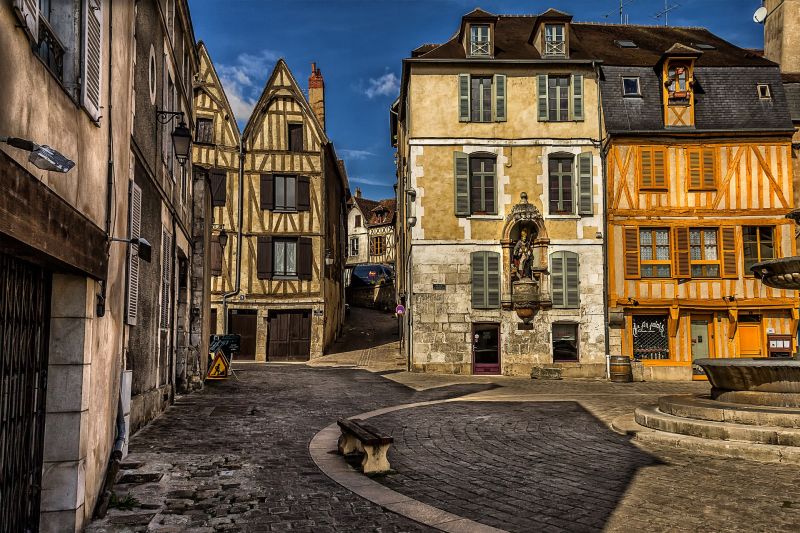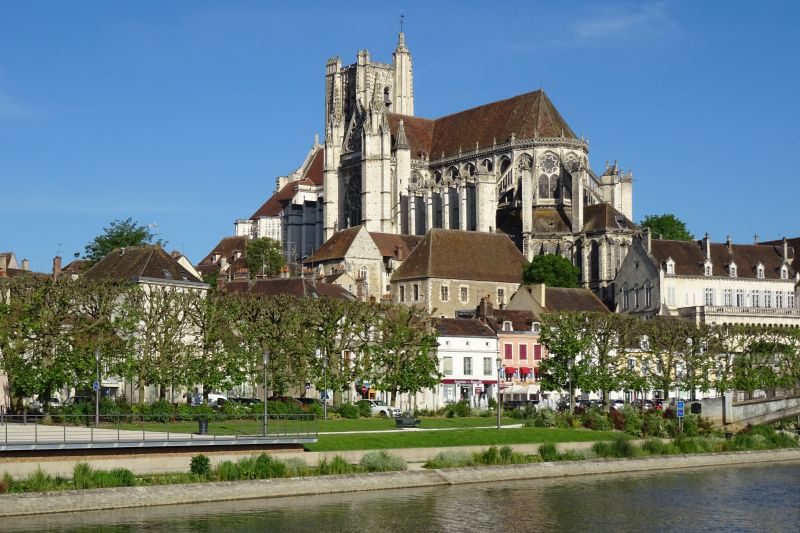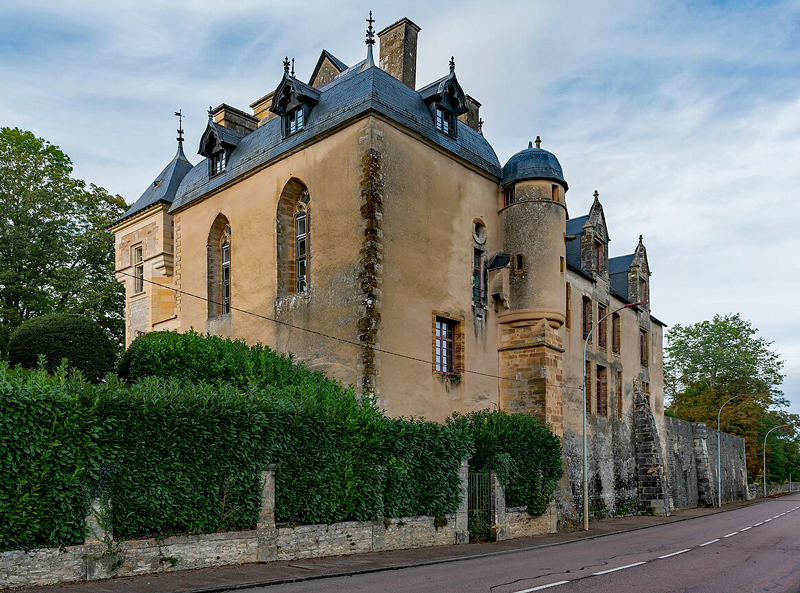Barging in France: Canal du Nivernais
Part 2: Towns and Villages
The Canal du Nivernais lies in northern Burgundy between the Canal Lateral à la Loire and the the Yonne river at Auxerre which meets up with the Canal de Bourgogne at Migennes, about 20km to the north.
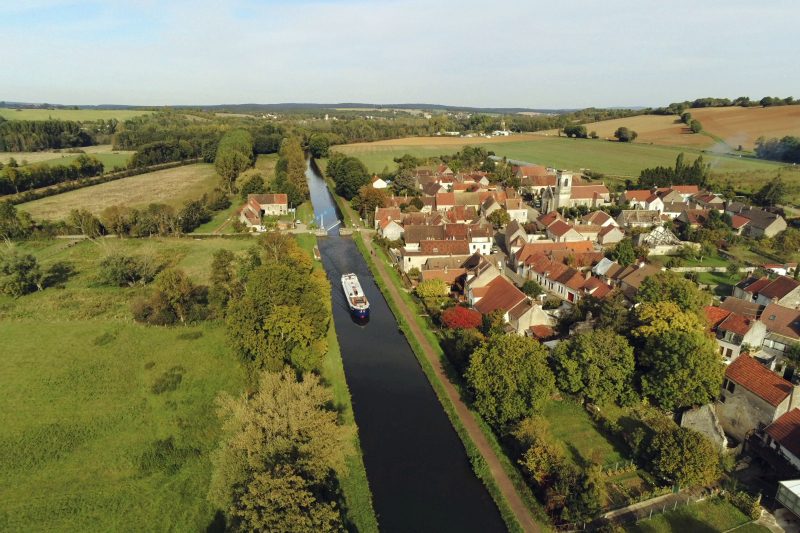
The Canal du Nivernais
The village of Gurgy belonged to the Abbey of Saint-Germain d'Auxerre from the 9th to 18th century. Within the village is a Neolithic necropolis (burial site) dating back 4000 to 5000 years, as well as a 13th-century Gothic church and a castle once affiliated with the Templars.
Auxerre is at the junction where the Canal du Nivernais meets the River Yonne heading south. This is a beautiful city and a pleasant port, with elegant buildings gracing its waterfront. Auxerre has been an important religious center and a sizeable market town for timber and wine. The River Yonne made Auxerre's fortune when rivers were the only viable means of transport in Europe. A good navigable river flowing towards large markets like Paris was the secret of wealth. The old town center has a pedestrianized main square, timber-framed buildings and a 15th century tower with a richly decorated 17th century clock. Cobblestone streets line the old quarter, with an open-air market and the spires of three churches contributing to an impressive skyline.
The Cathédral St-Étienne, completed in 1560, took over three centuries to build. The interior is illuminated by its fabulous 13th century stained glass; outside, flying buttresses lend support to the weight of the building.
The Musée St-Germain displays an exhibition of Gallo-Roman finds from the area. It occupies an abbey founded by the bishop Germanus of Auxerre. The bishop is best remembered for leading British natives to victory against Pictish and Saxon raiders in the early part of the 5th century. Decorated with contemporary frescoes, its crypts are said to be the oldest in France. The abbey is still open for religious services.

The distinctive skyline of Auxerre
Vincelles provides easy access to several wine villages with enticing cellars, including St-Bris-le-Vineux, Irancy, Coulanges, and Cravant. Across the river from Vincelles is a 13th century cellar where wine was loaded on barges for Paris; today, it is a discotheque.
Accolay is a sleepy village with springs in the center and a convenient canal-side bouledrome (a relatively new French word, meaning a court on which to play boules).
A branch canal follows the River Cure to Vermenton. The Cure is one of the main tributaries of the Yonne and was used intensively for the transportation of timber. The logs floated freely as far as Arcy and then formed into rafts for their journey down the Yonne, the Seine, and finally to Paris. Vermenton started as an ancient settlement on the Roman route between Rome and Boulogne, the Via Agrippa. Today, one can see the Notre Dame Church, Meridian sundial, and the old wash house. Close by, the Abbey of Reigny has exceptional 12th century architecture and a fascinating history. During the summer months, a series of concerts and exhibitions take place within the abbey complex. La Grande Grotte d'Arcy-sur-Cure, a system of underground caverns, has a subterranean lake and interesting geological formations.
Built on a rocky escarpment which overlooks the river, Mailly-le-Château is a maze of twisting little streets and higgledy-piggledy houses. A steep climb up a rocky path on the left bank of the river leads to a terrace in the Upper Village, where there is a 14th century castle and the 13th century church of Saint Adrian. The views of the Yonne Valley from the terrace are amazing.

L'Art de Vivre and the cliffs at Le Saussois
One more bend in the canal and the cliffs of Le Saussois appear on the right bank on the Canal du Nivernais. This 50m (165ft) high limestone wall dominates the Yonne and now serves as a training area for rock climbers. Footpaths will also allow you to reach the summit.
The Canal du Nivernais and the Yonne twist as one until Châtel-Censoir, which takes its name from the Bishop of Auxerre, St Censure. This town offers several interesting walks, beginning with the 15th century church of Saint-Potentien on the top of the hill overlooking the town. A harmonious complex of buildings is formed by the 11th century Roman choir, the 13th century chapter house, and the crypt.
Approaching Clamecy, the navigation alternates between the Canal du Nivernais and the Yonne. This town, at the confluence of the Yonne with the River Beuvron, is surrounded by water. It is often described as “the town of beautiful reflections.” Between the two rivers, the old quarter stands on a steep hill criss-crossed by a maze of narrow, winding streets and 12th-16th century houses.

An Aerial View of Clamecy
Clamecy served as a marshaling point for several crusades to the Holy Land. One crusader, Count William IV of Nevers, promised the Bishop of Bethlehem that should Bethlehem ever fall, he would be welcome in Clamecy. After the capture of Jerusalem in 1188, the bequest of the now deceased Count was honored and the Bishop of Bethlehem duly took up residence in the hospital of Panthenor. This remained the continuous seat of the Bishopric of Bethlehem in exile for almost 600 years until the French Revolution.
Although once an old medieval fortified town, Clamecy was also the center of the logging industry in the 19th century. From here, logs descended the rivers from the forests of the Morvan to be assembled in 235-foot rafts. The rafts of logs then floated to Paris, a great consumer of firewood. The Romain-Rolland museum devotes an entire room to this four hundred year era of log flotation. A bronze statue commemorates Jean Rouvet, who founded the flottage industry in 1549.
Chevroches, whose name derives from Cava Roca (hollow rock), is a hilltop village with lines of old fruit trees laden with mistletoe. The commune was a center of smelting activity from the 2nd to 4th centuries AD. Artefacts discovered in the village are displayed in a museum in Clamecy. The church of Saint Amateur dates to the 9th century.
The commune Villiers-sur-Yonne is within of the parish of communes of "des Vaux d'Yonne". This is the site of a Merovingian burial place, where tools, jewels, and arms are on display.
At Asnois you can visit Le Bouc qui Fume (The Smoking Billy Goat), a chapel-based antique/curiosity shop.
Surrounded by vineyards, the town of Tannay sits high on a hill overlooking the Yonne. Strolling through the village, you will see ancient houses dating from the 15th and 16th centuries, as well as the 12th century church of St-Léger. In the town's cellars, you can find the dry white wine with a delicious bouquet; a favorite of Louis XIII.
Dirol is a 13th century farming settlement with approximately 120 inhabitants. Of particular interest are two bascule bridges (drawbridges) which helped defend the hamlet from attacks in the middle ages. The drawbridge later guarded the approach to Chitry-les-Mines, whose "mines" refer to the small silver veins that were worked during the Renaissance. The four-towered château was a center of the Resistance during the Second World War.
Corbigny, known for its cattle market, was a stop-over for pilgrims traveling from Vézelay to St-James of Compostella. Five gates and fourteen towers fortified it, of which only one tower remains today.

L'Art de Vivre Cruising the Canal du Nivernais
Climbing toward the Canal du Nivernais summit, the pounds become shorter and the number of locks increases. In fact, there are 22 locks over a distance of less than four miles. At Sardy-lès-Épiry, a lock staircase groups a flight of 16 locks for a rise of 157 feet. By the 1950s, the threat of the closure of the canal was very real, and it was becoming difficult to justify paying permanent lock keepers at every lock.
One key factor which lead to the saving of this waterway was Roger Pilkington's voyage in his motor yacht Commodore. This cruise is beautifully described in his book “Small Boat Through France”. The decisive event that determined the canal's future, however, was brought on by Pierre-Paul Zivy, an Anglophile who had cruised multiple rivers and canals in England. He founded France's first fleet of inland waterway self-drive cruisers on the Marne. Assured the authorities would tackle the neglected maintenance, he launched the "Saint-Line" at the Baye summit level in 1964. Zivy lived in one of the old lock-keeper's cottages along the Canal du Nivernais and they have erected a silver bust of him holding a model lock as a memorial.
At Port-Brûlé is the entrance to the Yonne feeder canal, which supplies the northern descent of the main canal with water from the Pannecières reservoir. The summit pound of water stretches two and a half miles from Port-Brûlé to the tiny village of Baye. It passes through the three tunnels (695 feet, 880 feet, 2485 feet) carved out of the rock under La Collancelle. The approach to Collancelle is through deep, stone-lined cuttings running with waterfalls. At a major ornithological site at the nearby lake of Vaux, you can admire over 180 species of birds.
Châtillon-en-Bazois, with its impressive castle, begins the descent towards the Loire, passing through pastures of grazing white Charolais cattle. The vestiges of ancient stonework suggest that the canal may occupy the site of an old moat.
St-Léger-des-Vignes marks the junction of the Canal du Nivernais with the Loire.
Decize is a pretty little village on a former island in the Loire at the confluence with the River Aron. Here, the Loire is an important navigation aid as it forms the link between the Canal du Nivernais and the Canal Latéral à la Loire. Decize is an ancient settlement first noted in the Commentarii de Bello Gallico where Julius Caesar settled a dispute involving the Decetia, a local tribe, derived from the town's name. In the Middle Ages it belonged to the counts of Nevers, from whom it obtained a charter in 1226. A branch canal regulated by two locks connects the Canal du Nivernais to the Canal Latéral à la Loire.
Learn more about the Canal du Nivernais:
- The Canal du Nivernais: An Overview
- The Canal du Nivernais: Towns & Villages
- The Canal du Nivernais: Best Places to Visit
French Hotel Barges Cruising the Canal du Nivernais
L'ART DE VIVRE
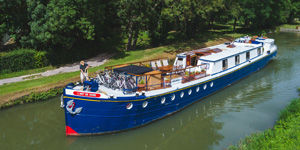
Northern Burgundy: Canal du Nivernais
Up to 8 guests
Charters and Cabin cruises
Themed Cruises:
Bike, Family, Golf, Tennis, Walking, Wine
HOME > REGIONS > France > Canal du Nivernais: Towns & Villages

